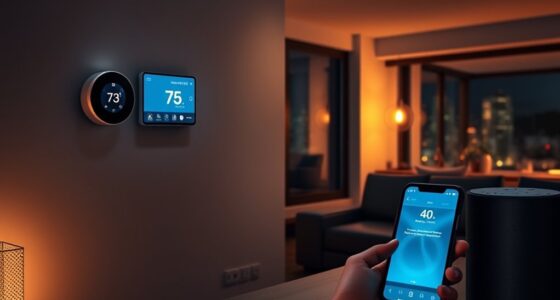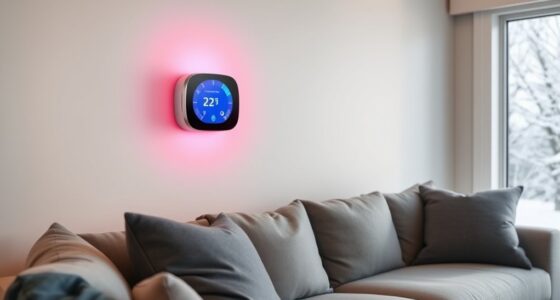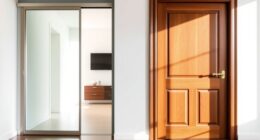To effectively use security cameras, focus on smart placement at entry points like doors and driveways, guaranteeing clear views and minimal blind spots. Be mindful of privacy laws—avoid capturing neighbors’ private spaces without permission. Position cameras high enough to prevent tampering and use night vision if needed. Securing your network and updating software helps prevent hacking. Following these guidelines ensures your system is both legal and effective—continue exploring to learn more tips for maximum security.
Key Takeaways
- Position cameras at entry points and vulnerable areas to maximize security coverage and minimize blind spots.
- Ensure cameras are installed high enough to prevent tampering while capturing clear footage.
- Be aware of local laws regarding recording private property and avoid capturing neighbors’ spaces without consent.
- Use night vision and proper lighting to maintain clear footage in low-light conditions.
- Regularly update security software and secure remote access to protect footage and prevent hacking.

Security cameras have become essential tools for safeguarding homes and businesses alike. They give you peace of mind by allowing you to keep an eye on your property remotely, whether you’re at work, on vacation, or just away for the evening. With remote monitoring, you can access live video feeds anytime, from anywhere, using your smartphone, tablet, or computer. This convenience means you’re always in control and can respond quickly if something seems amiss. However, while setting up your security system, it’s vital to understand the legal considerations involved. Laws about surveillance vary depending on your location, and failing to follow them can lead to legal trouble or privacy violations. For example, in many areas, you’re allowed to record areas on your private property, like your yard, but recording public spaces or neighbor’s property without their consent can be problematic. Knowing where and how to place your cameras ensures you’re compliant with local regulations and respect others’ privacy rights.
When it comes to placement, focus on areas that provide the most security coverage without infringing on others’ privacy. Typically, placing cameras at entry points such as front doors, back doors, and garages helps you monitor who comes and goes. It’s also smart to cover driveways, walkways, and any vulnerable windows. Position your cameras high enough to prevent tampering but low enough to capture clear images of faces and license plates. Keep in mind that the camera’s field of view should be wide enough to cover the target area without blind spots. Consider lighting conditions too; cameras with night vision or infrared capabilities are invaluable for 24/7 surveillance. Additionally, understanding local laws related to video recording can help prevent unintentional violations.
As you plan your setup, remember that remote monitoring offers convenience but also comes with responsibilities. Regularly update your security system’s software, change passwords, and ensure your network is secure to prevent hacking. This way, you protect not only your property but also your personal information. Additionally, familiarize yourself with the legal considerations for recording and sharing footage. If you’re unsure about specific rules in your area, consult local laws or a legal expert. Being proactive about these aspects helps you enjoy the benefits of security cameras without risking privacy violations or legal issues. Ultimately, smart placement combined with an understanding of remote monitoring and legal considerations makes your security system both effective and compliant.
Frequently Asked Questions
Can Security Cameras Record Audio Without Consent?
You might wonder if security cameras can record audio without your consent. In many areas, audio recording with security cameras requires explicit consent due to privacy laws. Laws vary by jurisdiction, but generally, you need to inform people if their conversations are being recorded. Without proper consent requirements, recording audio could be illegal, so always check local regulations before enabling audio recording on your security cameras.
How Do I Prevent My Security Cameras From Being Hacked?
To prevent your security cameras from being hacked, you need to prioritize strong security measures. Use camera encryption to protect your data, guarantee you update firmware regularly, and implement password protection with unique, complex passwords. Enable two-factor authentication if available, disable remote access when not needed, and keep your Wi-Fi network secure. These steps help safeguard your cameras, making it harder for hackers to access your footage or control your devices.
Are There Legal Restrictions on Camera Placement in Public Areas?
You should know that privacy laws and regulations govern camera placement in public areas. Generally, you can install cameras in public spaces for surveillance, but you must avoid invading people’s privacy, like recording private property or areas where individuals expect privacy. Local laws may restrict camera positions or require signage, so check your city’s rules on public surveillance to stay compliant and avoid legal issues.
What Are the Best Practices for Managing Multiple Cameras?
When managing multiple cameras, you should focus on optimizing camera angles to cover critical areas without overlaps. Set up privacy zones to prevent capturing private spaces, ensuring compliance with privacy laws. Regularly monitor footage and adjust angles as needed for better coverage. Clear labeling and organized placement help streamline management, making it easier to identify issues quickly. This approach keeps your system efficient, respectful of privacy, and effective in security coverage.
How Long Should Security Footage Be Stored?
You should determine the appropriate storage duration for your security footage based on your specific needs and legal requirements. Typically, footage retention ranges from 30 to 90 days, but some situations may require longer storage durations. Regularly review your storage capacity and delete outdated footage to maintain efficient management. By setting clear policies on footage retention, you guarantee your security system remains effective without compromising privacy or overwhelming storage resources.
Conclusion
While security cameras protect your home, they also invite scrutiny. Balancing safety with privacy means choosing discreet placements and respecting others’ boundaries. Think of your cameras as silent guardians—visible enough to deter intruders, yet mindful enough to preserve your neighbors’ peace. When you find that perfect middle ground, you create a secure space where trust and vigilance coexist. Ultimately, smart placement turns your cameras from intrusions into trusted protectors.









